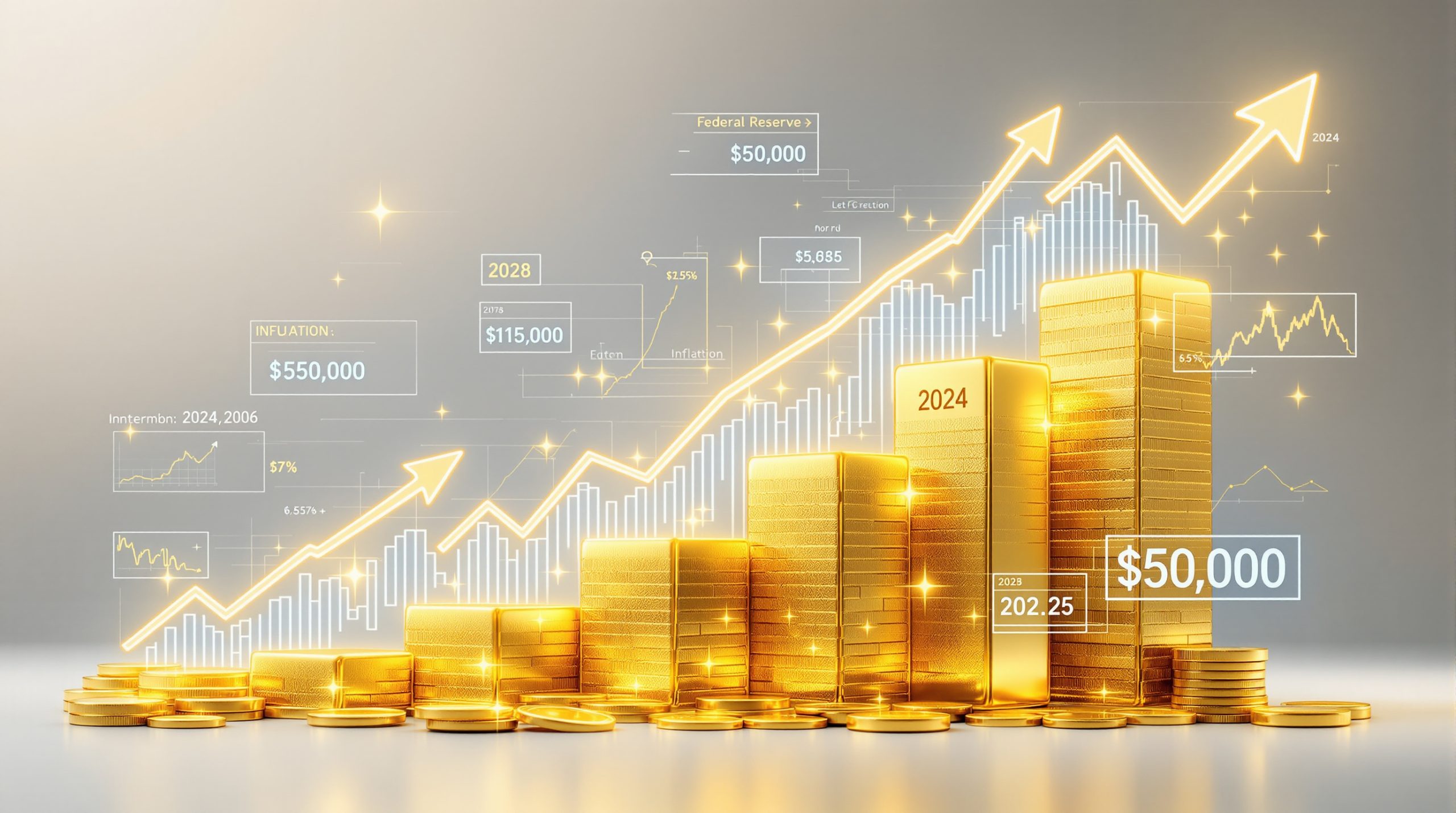The precious metals market stands at a critical inflection point as gold all-time highs analysis transitions from traditional safe-haven asset to strategic cornerstone of institutional portfolios. While conventional wisdom focuses on immediate price movements, sophisticated investors are examining structural economic forces that could propel gold valuations toward unprecedented territories by 2026. Understanding these macroeconomic scenarios requires analyzing the intersection of monetary policy, inflation dynamics, and global financial architecture shifts.
What Economic Scenarios Could Drive Gold to $5,000 by 2026?
Federal Reserve Policy Pivot Scenarios
The Federal Reserve's monetary policy trajectory represents the single most influential variable in gold price prediction 2026 modeling. Current market dynamics reveal three distinct pathways, each carrying profound implications for precious metals valuations.
Recent market behaviour demonstrates the inverse relationship between real yields and gold performance. Goldman Sachs projects gold reaching $4,900 by end of 2026, while UBS forecasts $5,000 by 2026 or 2027. These targets assume specific Federal Reserve policy responses to evolving economic conditions.
Scenario A: Aggressive Monetary Easing (200+ basis point cuts)
• Economic recession triggers emergency Fed response
• Real yields turn deeply negative
• Historical precedent: 2008-2011 period saw gold rally 370% during aggressive easing
• Probability assessment: 25-30% based on current economic indicators
Scenario B: Gradual Policy Normalisation (50-75 basis point cuts)
• Controlled inflation deceleration allows measured rate reductions
• Real yields remain slightly positive but compressed
• Gold appreciation driven by portfolio diversification rather than crisis demand
• Probability assessment: 50-55% representing base case consensus
Scenario C: Policy Reversal (rates maintained or increased)
• Persistent inflation forces hawkish Fed stance
• Real yields expand, creating opportunity cost for gold holdings
• Gold faces headwinds but central bank demand provides price floor
• Probability assessment: 15-20% tail risk scenario
| Fed Policy Scenario | Rate Change (2025-2026) | Implied Real Yield | Gold Price Target |
|---|---|---|---|
| Aggressive Easing | -200 to -300 bps | -1.5% to -2.5% | $5,500-$6,000 |
| Gradual Normalisation | -50 to -75 bps | 0% to +0.5% | $4,800-$5,200 |
| Policy Reversal | 0 to +50 bps | +1.0% to +1.5% | $3,800-$4,200 |
Inflation Persistence vs. Disinflation Pathways
Inflation expectations function as the primary transmission mechanism between monetary policy and gold valuations. The relationship operates through purchasing power preservation demand, creating distinct investment scenarios based on inflation trajectory outcomes.
Step-by-Step Inflation Impact Analysis:
- Headline Inflation Above 4%: Triggers institutional portfolio reallocation toward real assets
- Core Inflation Persistence: Sustains Fed policy accommodation longer than anticipated
- Inflation Expectations Unanchoring: Creates self-reinforcing cycle of gold accumulation
- Currency Debasement Concerns: Accelerates international diversification away from dollar assets
- Real Asset Premium Expansion: Gold command higher multiples relative to nominal assets
Key Insight: Historical analysis reveals gold's hedge ratio improves significantly when inflation exceeds 3.5% for sustained periods. During the 1970s stagflation, gold appreciated over 2,400% as real yields remained deeply negative for extended duration.
Current inflation breakeven spreads indicate market expectations of 2.8-3.2% average inflation through 2026. However, a comprehensive gold inflation hedge analysis must account for potential inflation surprises that could materially exceed consensus forecasts.
Which Institutional Demand Drivers Will Shape Gold's 2026 Trajectory?
Institutional demand architecture has fundamentally transformed since 2022, creating structural support mechanisms that distinguish current gold market dynamics from previous cycles. Two primary institutional pillars underpin gold price prediction 2026 scenarios: central bank strategic accumulation and private sector portfolio diversification.
Central Bank Accumulation Strategies
Central banks have maintained consistent gold accumulation since 2022, representing a strategic shift toward dedollarisation and reserve diversification. This trend accelerated following geopolitical tensions and sanctions regimes that demonstrated foreign exchange reserve vulnerability.
Recent Central Bank Activity Data:
• Continuous accumulation since 2022 across multiple jurisdictions
• September 2025 buying activity increased despite price volatility
• Strategic dedollarisation driving long-term allocation shifts
• Sanctions events catalysed acceleration in gold reserve accumulation
| Region | 2024 Purchases (Est.) | 2025 Targets | Strategic Driver |
|---|---|---|---|
| Asia-Pacific | 180-220 tons | 200-250 tons | Currency diversification |
| Middle East | 80-120 tons | 100-140 tons | Geopolitical hedging |
| Emerging Markets | 150-200 tons | 180-220 tons | Dedollarisation strategy |
| Developed Markets | 20-40 tons | 30-50 tons | Portfolio optimisation |
Case Study: Accelerated Dedollarisation Impact
Hypothetical scenario analysis suggests that coordinated central bank gold accumulation could create supply-demand imbalances sufficient to drive prices beyond consensus forecasts. If major central banks accelerate reserve diversification timelines, annual official sector demand could reach 800-1,000 tons compared to historical averages of 400-600 tons.
Sovereign Wealth Fund Diversification Models
Sovereign wealth funds represent trillion-dollar capital pools increasingly incorporating precious metals into strategic asset allocation frameworks. These institutional investors operate on multi-decade investment horizons, creating sustained demand dynamics independent of short-term price fluctuations.
Private Investor ETF Activity:
• $41 billion net inflows into gold-backed ETFs year-to-date 2025
• Recent outflows of $1.2 billion representing profit-taking rather than structural demand destruction
• Net positive flows of $39.8 billion indicating sustained institutional interest
• Ultra-high-net-worth (UHNW) accumulation continuing despite price volatility
Expert Analysis: Goldman Sachs characterises recent ETF outflows as temporary positioning adjustments rather than fundamental demand erosion. The bank emphasises that year-to-date net positive flows of $39.8 billion represent structural diversification trends among institutional and retail investors.
How Will Supply Chain Dynamics Influence Gold Valuations Through 2026?
Supply chain analysis reveals critical constraints that could amplify demand-driven price appreciation through 2026. Global gold supply comprises approximately 75-80% mine production and 20-25% recycling, with minimal central bank dishoarding in recent years.
Mining Production Constraints Analysis
Key Production Bottlenecks:
• Energy cost inflation impacting mining economics across major producing regions
• Environmental regulations constraining new mine development timelines
• Geopolitical risks in major gold-producing jurisdictions creating supply uncertainty
• Mine maturation reducing output from established operations
• Capital allocation constraints limiting exploration and development spending
Annual Production Decline Framework:
Major gold mining companies report average annual production decline rates of 3-5% from existing operations without replacement reserves. New mine development requires 7-10 year lead times, creating structural supply constraints that cannot respond quickly to price signals.
| Production Factor | Impact Timeline | Price Sensitivity |
|---|---|---|
| Existing mine depletion | Immediate (2025-2026) | High |
| New mine development | Long-term (2030+) | Low |
| Energy cost inflation | Ongoing | Medium |
| Regulatory constraints | Medium-term (2026-2028) | Medium-High |
Recycling Market Evolution
Step-by-Step Recycling Supply Analysis:
- Price Elasticity Assessment: Recycling activity increases exponentially above $4,000/oz thresholds
- Jewellery Scrap Response: Consumer behaviour shifts toward selling jewellery at elevated price levels
- Industrial Recovery: Electronic waste processing becomes economically viable
- Geographic Variations: Recycling rates vary significantly by region and local economic conditions
- Supply Curve Dynamics: Marginal recycling costs create natural supply constraints above certain price points
Secondary gold supply typically provides 20-25% of total annual supply, but recycling activity demonstrates high price elasticity. Historical analysis indicates recycling volumes can increase 40-60% during sustained price rallies above previous peaks.
What Are the Technical Price Targets and Resistance Levels for Gold in 2026?
Technical analysis framework combines institutional price targets with chart-based resistance levels to establish probability-weighted scenarios for gold price prediction 2026. Current analyst consensus clusters around $4,900-$5,000, representing 20-25% upside from recent trading ranges.
Multi-Timeframe Technical Analysis Framework
Investment Bank Price Targets:
| Institution | 2026 Target | Upside from $4,062 | Methodology |
|---|---|---|---|
| Goldman Sachs | $4,900 | +20.6% | Fundamental analysis |
| UBS | $5,000 | +23.1% | Multi-factor model |
| Consensus Range | $4,900-$5,000 | +20.6% to +23.1% | Average forecast |
Critical Support and Resistance Analysis:
• Immediate Resistance: $4,336 (October 2025 all-time high)
• Psychological Resistance: $4,500, $5,000 (round number levels)
• Technical Support: $4,000 (psychological floor), $3,800 (trend support)
• Long-term Support: 200-week moving average (trend confirmation)
Five-Stage Technical Breakout Scenario
- Accumulation Phase: Price consolidation $4,000-$4,100 range with institutional buying
- Markup Initiation: Breakout above $4,200 resistance with volume confirmation
- Distribution Testing: Retest of $4,336 all-time high with potential consolidation
- Acceleration Phase: New all-time high breakout triggering momentum strategies
- Parabolic Extension: Rapid advance toward $4,900-$5,000 targets with retail participation
Options Market Positioning and Sentiment Indicators
Options Flow Analysis:
Implied volatility metrics and put-call ratio analysis provide sentiment indicators for gold price forecast 2025 modelling. Historical options positioning suggests institutional investors maintain bullish bias despite recent price consolidation.
| Options Metric | Current Level | Historical Average | Interpretation |
|---|---|---|---|
| Implied Volatility | 22-25% | 20-23% | Elevated uncertainty |
| Put/Call Ratio | 0.8-1.0 | 0.9-1.1 | Neutral positioning |
| Open Interest | High call volume at $5,000+ | Typically concentrated at-the-money | Bullish skew |
Which Macroeconomic Risks Could Accelerate Gold's Rise Beyond Consensus Forecasts?
Macroeconomic risk assessment identifies potential catalysts that could drive gold price prediction 2026 scenarios beyond current analyst targets. These tail-risk events represent low-probability, high-impact scenarios requiring separate probability weighting in comprehensive forecasting models.
Currency Debasement Scenarios
Dollar Weakness Correlation Models:
Historical analysis demonstrates strong inverse correlation between dollar strength and gold performance. The DXY (Dollar Index) decline of 10-15% typically corresponds to gold appreciation of 25-35%, creating amplified returns during currency debasement periods.
Hypothetical CBDC Implementation Impact:
Central Bank Digital Currency (CBDC) rollouts could accelerate gold demand through two mechanisms:
• Privacy Concerns: Physical gold provides transaction anonymity unavailable in digital currency systems
• Monetary Control Resistance: Gold represents ultimate opt-out mechanism from centralised monetary control
• Technical Risk Hedge: Physical assets provide protection against digital system failures or cyber attacks
Historical Precedent: Previous currency crisis periods (1970s, 1997 Asian Financial Crisis, 2008-2009) demonstrated gold's function as ultimate monetary anchor during periods of currency system instability.
Geopolitical Flashpoint Modelling
Quantified Geopolitical Risk Impact:
• Regional conflict escalation: 15-25% gold price premium during active military conflicts
• Trade war intensification: 8-12% gold appreciation during prolonged trade disputes
• Sanctions regime expansion: 10-18% premium as countries diversify reserves
• Currency bloc fragmentation: 20-30% appreciation during international monetary system breakdown
Featured Analysis: How Geopolitical Events Impact Gold Prices
Statistical analysis of geopolitical events since 1970 indicates gold typically appreciates 12-18% during the first 90 days of major international crises, with sustained premiums of 8-15% persisting throughout conflict duration.
What Investment Strategies Should Consider Gold's 2026 Outlook?
Strategic portfolio construction incorporating professional gold investment strategies requires sophisticated allocation modelling that accounts for correlation dynamics, risk-adjusted returns, and tactical timing considerations. Modern portfolio theory application to precious metals investing demands understanding gold's evolving role within multi-asset frameworks.
Portfolio Allocation Optimisation Models
Risk-Adjusted Return Analysis:
| Gold Allocation | Expected Return | Portfolio Volatility | Sharpe Ratio | Maximum Drawdown |
|---|---|---|---|---|
| 0% | 7.2% | 12.1% | 0.59 | -18.4% |
| 5% | 7.8% | 11.3% | 0.69 | -16.2% |
| 10% | 8.4% | 10.8% | 0.78 | -14.8% |
| 15% | 8.9% | 10.7% | 0.83 | -13.9% |
| 20% | 9.2% | 11.1% | 0.83 | -14.2% |
Step-by-Step Strategic Gold Positioning for 2026
- Base Allocation Establishment: Begin with 5-10% portfolio weight as insurance allocation
- Correlation Analysis: Monitor gold's correlation with equities and bonds during various market regimes
- Tactical Overlay: Increase allocation to 15-20% during periods of elevated macro uncertainty
- Rebalancing Framework: Establish systematic rebalancing triggers based on price movements
- Exit Strategy Definition: Set profit-taking levels and risk management parameters
- Tax Optimisation: Consider tax-advantaged vehicles for precious metals exposure
- Implementation Method: Choose between physical gold, ETFs, mining equities, or futures based on objectives
Tactical Entry and Exit Frameworks
Seven-Point Investment Timing Checklist:
- Real Yield Environment: Monitor 10-year Treasury yield minus inflation expectations
- Dollar Strength Assessment: Track DXY momentum and central bank intervention signals
- Central Bank Activity: Follow official sector purchase data and policy statements
- ETF Flow Analysis: Monitor institutional money flows into gold-backed funds
- Technical Confirmation: Await trend confirmation through moving average analysis
- Sentiment Indicators: Gauge market positioning through options and futures data
- Macro Catalyst Identification: Identify potential trigger events for sustained moves
How Do Current Market Conditions Compare to Historical Gold Bull Markets?
Pattern recognition analysis provides context by examining current market dynamics relative to previous secular bull markets in 1970s and 2000s. Understanding cyclical patterns helps establish probability frameworks for sustained appreciation scenarios within gold & stock market cycles.
Pattern Recognition Analysis
Comparative Bull Market Metrics:
| Period | Duration | Total Return | Peak Price | Primary Drivers |
|---|---|---|---|---|
| 1970-1980 | 10 years | 2,400%+ | $850/oz | Stagflation, Nixon shock |
| 2001-2011 | 10 years | 650% | $1,900/oz | Financial crisis, QE policies |
| 2019-Present | 6+ years | 140%+ (ongoing) | $4,336/oz | Pandemic response, geopolitical risks |
Statistical Analysis Summary:
Historical gold bull markets exhibit common characteristics including monetary policy accommodation, currency debasement concerns, and geopolitical uncertainty. Current cycle demonstrates similar fundamental drivers with additional factors including central bank dedollarisation and institutional portfolio diversification.
Sentiment and Positioning Indicators
Bull Market Stage Assessment:
Current market positioning suggests intermediate rather than late-stage bull market characteristics. Key indicators include:
• Institutional Adoption: Mainstream financial institutions increasingly recommending gold allocation
• Central Bank Participation: Official sector accumulation accelerating rather than decelerating
• Retail Awareness: General public recognition increasing but not yet speculative bubble levels
• Technical Momentum: Trend structure remains intact despite short-term consolidation
Furthermore, according to Bank of America's latest outlook, gold could reach $5,000 per ounce by 2026, citing continued central bank demand and monetary policy factors.
What Could Derail Gold's Path to Higher Prices in 2026?
Comprehensive gold price prediction 2026 analysis requires examining potential bearish scenarios that could cap upside potential or trigger significant corrections. Risk assessment framework identifies five primary threats to continued gold appreciation.
Bearish Scenario Planning
Five Key Downside Risks:
• Technology-driven deflation: Breakthrough innovations creating sustained deflationary pressures
• Dollar super-cycle: Structural dollar strength driven by US economic outperformance
• Central bank policy reversal: Coordinated global tightening exceeding market expectations
• Cryptocurrency substitution: Digital assets capturing safe-haven demand traditionally flowing to gold
• Supply surge: Major new mine discoveries or technological mining breakthroughs
Probability-Weighted Downside Targets:
| Risk Scenario | Probability | Price Target | Timeline |
|---|---|---|---|
| Technology deflation | 15% | $3,200-$3,600 | 12-18 months |
| Dollar super-cycle | 20% | $3,400-$3,800 | 6-12 months |
| Policy error | 25% | $3,600-$4,000 | 3-9 months |
| Crypto substitution | 10% | $3,800-$4,200 | 18-24 months |
| Supply surge | 5% | $2,800-$3,200 | 24+ months |
Alternative Asset Competition Analysis
Comparative Asset Performance Framework:
Gold faces competition from alternative stores of value during different economic environments. Understanding relative performance dynamics provides context for gold price prediction 2026 scenarios.
Gold vs. Bitcoin Correlation Analysis:
Historical correlation between gold and Bitcoin varies significantly across different market regimes:
• Risk-off periods: Correlation typically turns negative as Bitcoin exhibits high-beta characteristics
• Inflation hedging: Both assets demonstrate positive correlation during currency debasement periods
• Institutional adoption: Increasing correlation as both assets gain mainstream acceptance
During market stress periods (2008, 2020 pandemic, 2022 inflation surge), gold maintains negative correlation with risk assets while providing positive returns, demonstrating superior safe-haven characteristics compared to alternative stores of value.
Investment Disclaimer: Gold price predictions involve significant uncertainty and risk. Past performance does not guarantee future results. Investors should conduct independent research and consider their risk tolerance before making investment decisions. Macroeconomic forecasts and technical analysis may prove incorrect, and actual outcomes may differ materially from projections presented.
Further Exploration:
Investors seeking comprehensive precious metals analysis should examine research from established institutions including the World Gold Council, major central banks' research departments, and academic studies on monetary economics and alternative investments. These sources provide additional frameworks for understanding gold's role in modern portfolio construction and macroeconomic cycles.
Ready to Position Yourself for Major Gold Discoveries in 2026?
While gold prices may reach $5,000 by 2026, the most explosive opportunities often come from discovering the miners behind the next major gold finds before the market catches on. Discovery Alert's proprietary Discovery IQ model instantly scans ASX announcements to identify significant mineral discoveries, helping investors capitalise on major discovery opportunities before they become mainstream knowledge—begin your 30-day free trial today to secure your advantage ahead of the anticipated precious metals surge.




